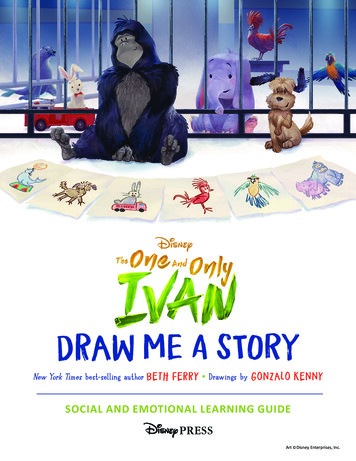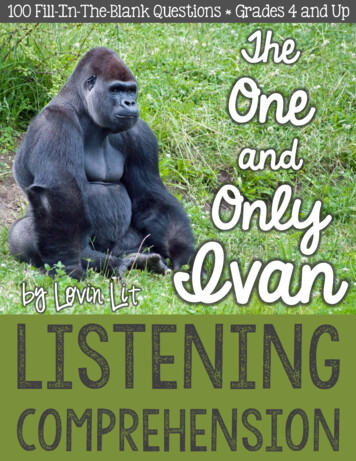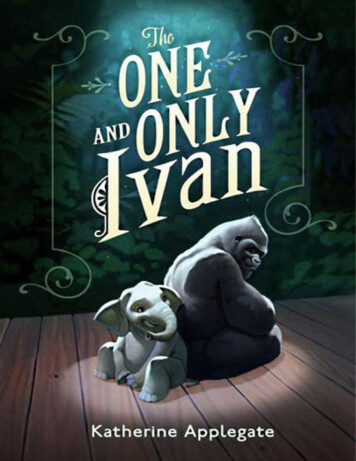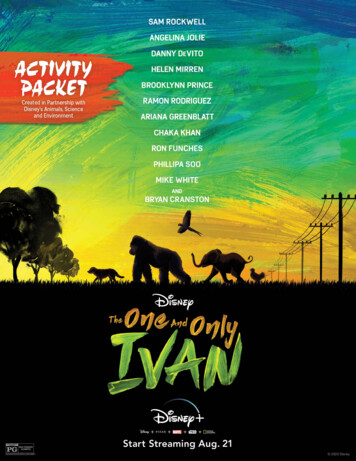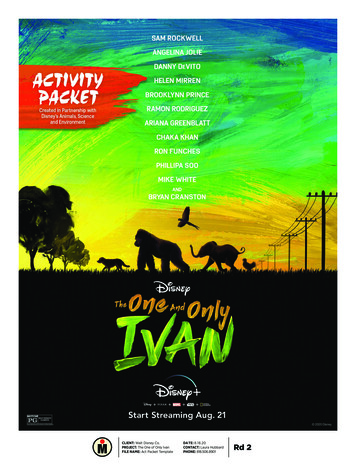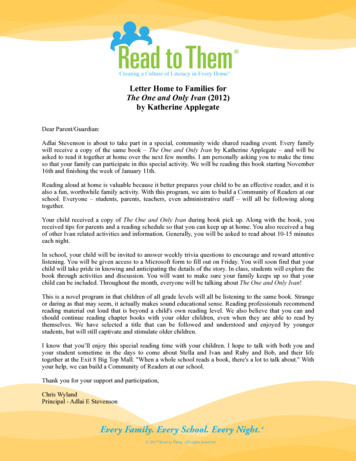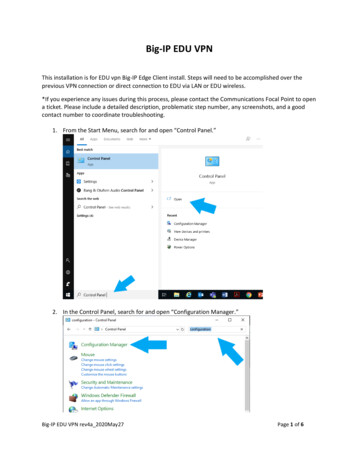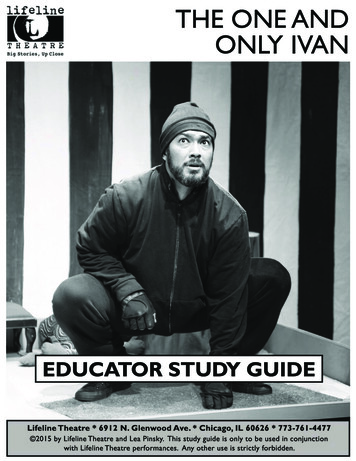
Transcription
IntroductionLifeline Theatre’s award-winning adaptations of children’s literature inspire a love ofreading that will activate your students’ imaginations and stay with them throughout theirlives. Every year, Lifeline Theatre’s Student Matinee Program serves over 3,000 students, 40schools, 129 classrooms, and 222 teachers with school-day performances of our seasonproductions.We encourage you to use this study guide to enrich your students’ experience of The Oneand Only Ivan and enhance the educational value of the production.Preparing for Your Field TripBefore the Play: Discuss Appropriate BehaviorHave a discussion with your students about proper theatre etiquette. For example, it’s okayto clap and laugh, but it’s not okay to talk to your neighbor. Have students compare andcontrast the difference between watching a movie and watching a play. Ask if students havebeen to a play before. If so, what play? What was the experience like? Talk about theconcentration that performing in a play requires, and ask the students what they finddistracting when they are trying to accomplish a task in front of people. How can they helpthe actors succeed and do a good job? Let students know that in plays, actors sometimesplay several different characters, and change roles by simply swapping out costume piecesand altering their voices and bodies.After the Play: Reflect on the ExperienceAsk students if they enjoyed the play. Based on this experience, would they like to see otherplays? If they’ve seen plays before, how did this play compare? What happened that theyweren’t expecting? How was seeing a play a different experience than seeing a movie?Have the students write a review of the play. Encourage students to be specific about whythey enjoyed a certain part of the play. If they liked a scene because it was funny, have themexplain why it was funny, what the characters did or said that was funny, etc. Have thestudents draw a picture or make a collage of their favorite scene or character. Have themshow their picture to the class and explain why that scene or character was their favorite.3
Traditional Plays vs. Literary AdaptationsLifeline Theatre’s KidSeries productions are often adaptations of picture books and shortstories for children. Sometimes the playwright is very faithful to the source material, andsometimes the original book is simply an inspiration. We encourage you to discuss theelements of each version and compare/contrast the two both before and after you see theplay.Before the Play: Get to Know the Original StoryRead the story to your students, or have them read the book themselves, before theproduction. After reading the book, discuss it with your students, using these questions aslaunch pads: Who are the characters in the story? What happens in the beginning of the story? The middle? The end? Is there a character in the story you don’t like? What makes you dislike this character? How do you think he/she might be portrayed in the stage version? What do you think you will see on stage as the actors tell this story? How might the play be different from the story? How might it be the same?Beginning, Middle and EndTo encourage sequential thinking, have students act out the beginning, middle and end ofthe story. Split the students into three groups (or more, depending on the number ofstudents in your class) and have one group enact the beginning, another group enact themiddle, and the final group the end. Have the students watching the performances help thegroup to remember any parts they may have left out. Give the groups the chance to redotheir performances, including any elements suggested by their classmates.After the Play: Compare/Contrast the Story to the Play How were the book and the play different? How were the book and the play the same? What elements of the play surprised you? Which did you enjoy more, reading the book or watching the play? What was your favorite part of the play? Was that your favorite part of the book, too? Were there any characters in the book that were not in the play, or vice versa? Why do you think the playwright added or subtracted certain parts?4
Jobs in the Theatre: Behind the ScenesBefore the Play: Prepare Your Students to Observe All Aspects of the ProductionWhen we create a play at Lifeline Theatre, we have a community of artists working togetherto make a complete production. Ask students to be particularly observant during theperformance for the parts of the show that are done by the various people listed below:Playwright/Adaptor/Author – writes the playComposer – writes the music for the showLyricist – writes the words (or “lyrics”) for the songs in the playDirector – directs the play - makes decisions about costumes, lights, sets, and what theactors do onstageChoreographer – creates and teaches the actors the dances in the showLighting Designer – designs and hangs the lights for the show; designs lighting effectsSet Designer – designs and builds the scenery and props for the showSound Designer – designs and records the sound effects for the showCostume Designer – designs and finds or makes the costumes for the showStage Manager – helps the director during rehearsals; sets props and scenery before eachperformance; runs the sound and lights during the performanceActors – perform the playAfter the Play: Discuss the Students’ ObservationsAsk the students what they noticed about the “behind-the-scenes” jobs: How did the costume designer make the actors look like the characters theywere playing? What about their costumes helped you to know what kind of people oranimals they were? Did you have a favorite costume in the show? Which one? Why was it yourfavorite? If there were animal costumes, how did the costume designer create them sothat they would look more like animals than people? What are some of the locations the play took place in? How did the set designer make the settings look realistic? What sound effects did you hear in the play? How did those sound effectshelp you to know what was happening in the play? If there was music, why do you think the composer chose the styles of musicthey did? What sorts of music would not make sense with the story?5
Synopsis of the PlayIvan is a silverback gorilla who was born in the wild but taken into captivity at a very youngage. He was raised in Mack’s home until he got too big and started breaking things aroundthe house. Mack is the owner of the Big Top Mall and decided he would build a domain forIvan there. When Ivan was new to the mall he attracted many visitors and Mack put upbillboard advertising that the Big Top Mall was the home of The One and Only Ivan, mightysilverback! Ivan has lived in his small domain at the Big Top Mall ever since.As time went on Ivan grew older and attracted less and less visitors. Now he spends mostof his days watching television, the only place he has ever seen other creatures like him. Hismain friend is Stella, the retired circus elephant who also lives in a domain at the Big TopMall. She has a bad foot injury that bothers her and a perfect memory so she is able to tellIvan stories about what it was like living in the circus where her foot was hurt. Ivan, on theother hand, can’t remember much of anything from his past aside from occasionalflashbacks that he attempts to piece together throughout the course of the play.Ivan’s other friends are Bob, the stray dog who sneaks into his cage at night to sleep on hisbelly, George the friendly janitor, and his daughter Julia – a young artist who often bringsIvan art supplies to use. Ivan is an artist as well. He likes to draw pictures of different thingsin his domain like bananas and beetles.Mack sells Ivan’s art to customers in an attempt to make more money because the Big TopMall is not doing so well. Mack is always looking for ways to attract more visitors and oneday he brings in a new attraction, a baby elephant named Ruby. Stella is distraught at theidea that Ruby will have to spend the rest of her life alone in a tiny domain at the Big TopMall. Before Stella dies from the infection in her foot, she makes Ivan promise that he willsave Ruby.Ivan does not know what he will do until he sees a commercial for the zoo on his TV and anidea strikes him. He will have to paint a giant picture of a zoo; the place that Ruby should golive! He paints many small pictures that will fit together like puzzle pieces to make a giantposter. He is able to hide these small pictures in his cage and overcome various setbacksuntil his work of art is complete. Julia is able to understand his drawing and convinces herfather to help her cover up the billboard with Ivan’s drawing.The poster attracts so much attention that a zookeeper is brought in to remove all of theanimals from the Big Top Mall and take them to the zoo where they will be better cared for.Ivan is able to save Ruby, make new friends, and become the mighty silverback he hadalways wanted to be.7
My Favorite AnimalIn The One and Only Ivan, Ivan’s final home is a zoo, where many wild animals live safely and areprotected. What is your favorite animal? Maybe you have seen an animal at the zoo that you love,or in books, magazines, or videos. How much do you know about this animal? See what youknow, and what you can still find out!What is your favorite animal?Why is it your favorite animal?Where does it live in the wild?What does it look like? (size, color, distinctive features)What kind of foods does it eat?What sounds does this animal make?If you have seen this animal at the zoo- what are some things this animal likes to havein its domain?If you have seen this animal at the zoo- was it doing when you saw it?roDo you know any other facts about your favorite animal?ON THE BACK: Draw a picture of your favorite animal!8
NEW PLACESIn The One and Only Ivan, Ivan the gorilla gets taken to places he has never been before.At first, the place felt unknown and scary, but soon he found things that made him feelmore comfortable and happy.You have probably visited a new place in your life that felt a little scary at first. Maybe thedoctor or dentist, or a new school, or a family member you haven’t meat before . Writeabout how that felt, and what you or someone else did to help you feel more comfortable(and happy, maybe) in that place.I remember .10
Create Your Own ZooIn the play, Ivan paints a picture of his dream home for Ruby at thezoo. Now it’s your turn to draw the ideal habitats for your favorite zooanimals. Think about what kinds of things different animals need tohave in their homes and fill in this zoo!11
Student Review of The One and Only IvanBy:I give this play a (circle the number of stars): My favorite part of the play wasbecause.My favorite character wasbecause.If I had choose what I liked best, I would choose (circle one)the storythe charactersthe musicthe costumesthe scenerybecause.12
Ivan there. When Ivan was new to the mall he attracted many visitors and Mack put up billboard advertising that the Big Top Mall was the home of The One and Only Ivan, mighty silverback! Ivan has lived in his small domain at the Big Top Mall ever since. As time went on Ivan grew older
